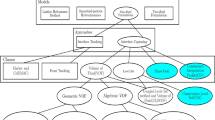Abstract
Discontinuous Galerkin (DG) method is known to have several advantages for flow simulations, in particular, in flexible accuracy management and adaptability to mesh refinement. In the present work, the DG method is developed for numerical simulations of both temporally and spatially developing mixing layers. For the temporally developing mixing layer, both the instantaneous flow field and time evolution of momentum thickness agree very well with the previous results. Shocklets are observed at higher convective Mach numbers and the vortex paring manner is changed for high compressibility. For the spatially developing mixing layer, large-scale coherent structures and self-similar behavior for mean profiles are investigated. The instantaneous flow field for a three-dimensional compressible mixing layer is also reported, which shows the development of large-scale coherent structures in the streamwise direction. All numerical results suggest that the DG method is effective in performing accurate numerical simulations for compressible shear flows.
Similar content being viewed by others
References
Brown, G.L., Roshko, A.: On density effects and large structures in turbulent mixing layers. J. Fluid Mech. 29, 775–816 (1974)
Jackson, T.L., Grosch, C.E.: Inviscid spatial stability of a compressible mixing layer. J. Fluid Mech. 208, 609–637 (1989)
Ragab, S.A., Wu, J.L.: Linear instabilities in two-dimensional compressible mixing layers. Phys. Fluids A 1(6), 957–966 (1989)
Clemens, N.T., Mungal, M.G.: Large-scale structures and entrainment in the supersonic mixing layer. J. Fluid Mech. 284 171–216 (1995)
Rossmann, T., Mungal, M.G., Hanson, R.K.: Evolution and growth of large-scale structures in high compressibility mixing layers. J. Turb. 25 1–19 (2002)
Papamoschou, D., Roshko, A.: The compressible turbulent shear layer: an experimental study. J. Fluid Mech. 197 453–477 (1988)
Goebel, S.G., Dutton, J.C.: Experimental study of compressible turbulent mixing layers. AIAA J. 29(4), 538–46 (1991)
Elliot, G.S., Samimy, M., Arnette, S.A.: The characteristics and evolution of large-scale structures in compressible mixing layers. Phys. Fluids 7(4), 864–876 (1995)
Li, Q.B., Fu, S.: Numerical simulation of high-speed planar mixing layer. Computers and Fluids 32, 1357–1377 (2003)
Lele, S.K.: Direct numerical simulation of compressible free shear flows. AIAA-89-0374, 1989
Bernard P.S.: Grid-free simulation of the spatially growing turbulent mixing layer. AIAA J. 46(7), 1725–1737 (2008)
Stanley, S., Sarkar, S.: Simulations of spatially developing two-dimensional shear layers and jets. Theoret. Comput. Fluid Dynamics 9, 121–147 (1997)
Rogers, M.M., Moser, R.D.: Direct simulation of a self-similar turbulent mixing layer. Phys. Fluids 6(2), 903–923 (1994)
Moser, R.D., Rogers, M.M.: The three-dimensional evolution of a plane mixing layer: paring and transition to turbulence. J. Fluid Mech. 247, 275–320 (1993)
Vreman, A.W., Sandham, N.D., Luo, K.H.: Compressible mixing layer growth rate and turbulence characteristics. J. Fluid Mech. 320, 235–258 (1996)
Fu, D.X., Ma, Y.W.: Direct numerical simulation of coherent structures in planar mixing layer. Science in China A, 26(7), 657–664 (1996)
Passot, T., Pouquet, A.: Numerical simulation of compressible homogeneous flows in the turbulent regime. J. Fluid Mech. 181, 441–466 (1987)
Lee, S., Lele, S.K., Moin, P.: Eddy shocklets in decaying compressible turbulence. Phys. Fluids 3(4), 657–664 (1990)
Kennedy, C.A., Carpenter, M.H.: Several new numerical methods for compressible shear-layer simulations. Appl. Numer. Math. 14, 397–433 (1994)
Li, Q., Luo, J.R., Zhang, H.X.: The numerical simulations on the shocklets of the mixing layers where the convective Mach number is transonic. In: Proceeding of the 6th Asia Computational Fluid Dynamics Conference, Taipei, October 24–27, 2005
Cockburn, B., Shu, C.W.: TVB Runge-Kutta local projection discontinuous Galerkin finite element method for scalar conservation laws II: General framework. Math. Comp. 52, 411–435 (1989)
Cockburn, B., Lin, S.Y., Shu, C.-W.: TVB Runge-Kutta local projection discontinuous Galerkin finite element method for conservation laws III: One dimensional systems. J. Comput. Phys. 84, 90–113 (1989)
Jiang, G., Shu, C.-W.: On cell entropy inequality for discontinuous Galerkin methods. Math. Comput. 62, 531–538 (1994)
Biswas, R., Devine, K.D., Flaherty, J.: Parallel, adaptive finite element methods for conservation laws. Appl. Numer. Math. 14, 255–283 (1994)
Bassi, F., Rebay, S.: Numerical evaluation of two discontinuous Galerkin methods for the compressible Navier-Stokes equations. Int. J. Numer. Meth. Fluids 40, 197–207 (2000)
van der Vegt, J.J.W., van der Ven, H.: Discontinuous Galerkin finite element method with anisotropic local grid refinement for inviscid compressible flows. J. Comput. Phys. 141, 46–77 (1998)
Cockburn, B., Shu, C.-W.: Runge-Kutta discontinuous Galerkin methods for convection-dominated problems. J. Sci. Comput. 16, 173–261 (2001)
Shu, C.-W., Osher, S.: Efficient implementation of essentially non-oscillatory shock-capturing schemes. J. Comp. Phys. 77, 439–471 (1988)
Xu, Z., Shu, C.-W.: Anti-diffusive flux corrections for high order finite difference WENO schemes. J. Comp. Phys. 205, 458–485 (2005)
Sandham, N.D., Yee, H.C.: A numerical study of a class of TVD schemes for compressible mixing layers. NASA TM 102194 (1989)
Sandham, N.D.: The effect of compressibility on vortex pairing. Phys. Fluids 6(2), 1063–1072 (1994)
Sandham, N.D., Reynolds, W.C.: Some inlet-plane effects on the numerically simulated spatially-developing mixing layer. Turbulent Shear flows 6, 441–454 (1989)
Jeong, J., Hussain, F.: On the identification of a vortex. J. Fluid Mech. 285, 9–14 (1995)
Shi, X.T., Chen, J., She, Z.S.: Visualization of compressibility effects on large-scale structures in compressible mixing layers. J. Vis. 13, 273–274 (2010)
Author information
Authors and Affiliations
Corresponding author
Additional information
The project was supported by the National Natural Science Foundation of China (90716008,10572004 and 10921202), MOST 973 Project (2009CB724100) and CSSA.
Rights and permissions
About this article
Cite this article
Shi, XT., Chen, J., Bi, WT. et al. Numerical simulations of compressible mixing layers with a discontinuous Galerkin method. Acta Mech Sin 27, 318–329 (2011). https://doi.org/10.1007/s10409-011-0433-0
Received:
Revised:
Accepted:
Published:
Issue Date:
DOI: https://doi.org/10.1007/s10409-011-0433-0




